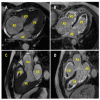Cardiac Abnormalities in Hypereosinophilic Syndromes
- PMID: 39607243
- PMCID: PMC11634209
- DOI: 10.36660/abc.20240190
Cardiac Abnormalities in Hypereosinophilic Syndromes
Erratum in
-
October 2024 Issue, vol. 121(10): e20240190.Arq Bras Cardiol. 2025 Feb 10;122(2):e20250038. doi: 10.36660/abc.20250038. Arq Bras Cardiol. 2025. PMID: 39936739 Free PMC article. English, Portuguese.
Abstract
Hypereosinophilia (HE) is defined as an eosinophil count exceeding 1500 cells/microL in peripheral blood in two tests, performed with an interval of at least one month and/or anatomopathological confirmation of HE, with eosinophils comprising more than 20% of all nucleated cells in the bone marrow. Hypereosinophilic syndrome (HES) indicates the presence of HE with organ involvement due to eosinophil action, which can be classified as primary (or neoplastic), secondary (or reactive), and idiopathic. Cardiac involvement occurs in up to 5% of cases in the acute phase and 20% of the chronic phase of the disease, ranging from oligosymptomatic cases to fulminant acute myocarditis or chronic restrictive cardiomyopathy (Loeffler endomyocarditis). However, the degree of cardiac dysfunction does not directly correlate with the degree of eosinophilia. The cardiac involvement of HES occurs in three phases: initial necrotic, thrombotic, and finally necrotic. It can manifest as heart failure, arrhythmias, and thromboembolic phenomena. The diagnosis of cardiopathy is based on multimodality imaging, with an emphasis on the importance of echocardiography (echo) as the primary examination. TTE with enhanced ultrasound agents can be used for better visualization, allowing greater accuracy in assessing ventricular apex, and myocardial deformation indices, such as longitudinal strain, may be reduced, especially in the ventricular apex (reverse apical sparing). Cardiac magnetic resonance imaging allows the characterization of subendocardial late gadolinium enhancement, and endomyocardial biopsy is considered the gold standard in diagnosing cardiopathy. Treatment is based on the etiology of HES.
Figura Central : Anormalidades Cardíacas nas Síndromes Hipereosinofílicas Abordagem sugerida em pacientes com Síndromes Hipereosinofílicas (SHE) e suspeita de acometimento cardíaco. BNP: peptídeo natriurético tipo B; ETT: ecocardiograma transtorácico; RMC: ressonância magnética cardíaca; TMO: tratamento medicamentoso otimizado.
Plain language summary
Central Illustration : Cardiac Abnormalities in Hypereosinophilic Syndromes Suggested approach in patients with HES and suspected cardiac involvement. Source: Adapted.29 BNP: brain natriuretic peptide; CMR: cardiac magnetic resonance imaging; TTE: transthoracic echocardiogram; GDMT: guideline-directed medical treatment; ECG: electrocardiogram; HES: hypereosinophilic syndromes.
Conflict of interest statement
Figures






References
-
- Chusid MJ, Dale DC, West BC, Wolff SM. The Hypereosinophilic Syndrome: Analysis of Fourteen Cases with Review of the Literature. Medicine. 1975;54(1):1–27. - PubMed
Publication types
MeSH terms
LinkOut - more resources
Full Text Sources
Miscellaneous

